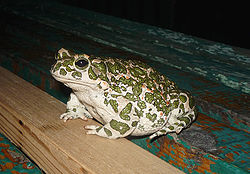European green toad
| European green toad | |
|---|---|
 | |
| Scientific classification | |
| Domain: | Eukaryota |
| Kingdom: | Animalia |
| Phylum: | Chordata |
| Class: | Amphibia |
| Order: | Anura |
| Family: | Bufonidae |
| Genus: | Bufotes |
| Species: | B. viridis |
| Binomial name | |
| Bufotes viridis (Laurenti, 1768) | |
 | |
| European green toad range | |
| Synonyms[2] | |
| |

The European green toad (Bufotes viridis) is a species of true toad found in steppes, mountainous areas, semi-deserts, urban areas and other habitats in mainland Europe, ranging from far eastern France and Denmark to the Balkans, Western Russia and the Caucasus.[3] As historically defined, the species ranged east through the Middle East and Central Asia to western China, Mongolia and northwestern India, and south through Italy and the Mediterranean islands to North Africa.
Following genetic and morphological reviews, 14 populations (all largely or entirely Asian, except for the African and Balearic green toads) are now regarded as separate species. These species and the European green toad are placed in their own genus Bufotes, but they were included in Bufo.[4][5]
Description
[edit]This section includes a list of general references, but it lacks sufficient corresponding inline citations. (November 2015) |
The spots on the back vary from green to dark brown and sometimes red spots appear, too. The underside is white or very lightly coloured. The European green toad will change colour in response to heat and light changes. Females are larger than males and can lay 9,000 to 15,000 eggs at a time.

It can reach a maximum size (head and body length) of 10 centimetres (3.9 in), but growth to this size is rare.[6]
Behavior
[edit]This species of toad is mainly nocturnal, although diurnal behaviors are sometimes recorded during parts of the year, especially in spring.[7] It loves warm summers with high water temperatures and in order to avoid the cold weather it hibernates during the winter. Its lifespan is 8-9 years in captivity and up to 7 years in the wild.[8]
Diet
[edit]Bufotes viridis eats a variety of insects and invertebrates, mainly crickets, meal worms, small butterflies, earthworms, moths, beetles, ants, spiders[9] and caterpillars. There has also been a reported attack on a bat.[10]
Defense mechanism
[edit]The European green toad has the ability to secrete defensive toxins from its parotid glands and these toxins are effective enough to kill most of the toad's predators. They are harmless to humans when contact is made with the skin.[7]
References
[edit]- ^ IUCN SSC Amphibian Specialist Group (2023). "Bufotes viridis". IUCN Red List of Threatened Species. 2023: e.T182530066A730332. doi:10.2305/IUCN.UK.2023-1.RLTS.T182530066A730332.en. Retrieved 8 May 2024.
- ^ "Bufotes viridis ". Amphibian Species of the World 6.0, an Online Reference. American Museum of Natural History. research.amnh.org/vz/herpetology/amphibia.
- ^ "Green Toad (Bufotes viridis)".
- ^ Dufresnes, C.; et al. (2019). "Fifteen shades of green: The evolution of Bufotes toads revisited". Molecular Phylogenetics and Evolution. 141: 106615. Bibcode:2019MolPE.14106615D. doi:10.1016/j.ympev.2019.106615. PMID 31520778. S2CID 202573454.
- ^ Frost, Darrel R. (2020). "Search for Taxon: Bufotes". Amphibian Species of the World, an Online Reference. Version 6.0. American Museum of Natural History, New York. Retrieved 8 January 2020.
- ^ Arnold EN, Burton JA (1978). A Field Guide to the Reptiles and Amphibians of Britain and Europe. London: Collins. 272 pp. ISBN 0 00 219318 3. (Bufo viridis, p. 74 + Plate 8 + Map 33).
- ^ a b "Bufotes viridis - hepretofauna.gr". www.herpetofauna.gr (in Greek). Retrieved 2025-03-25.
- ^ "European green toad- Skansen". www.skansen.se. Retrieved 2024-08-26.
- ^ "AmphibiaWeb - Bufotes viridis".
- ^ Mikula P (2015). "Fish and amphibians as bat predators". European Journal of Ecology. 1 (1): 71–80. doi:10.1515/eje-2015-0010.
Further reading
[edit]- Laurenti JN (1768). Specimen medicum, exhibens synopsin reptilium emendatam cum experimentis circa venena et antidota reptilium austriacorum. Vienna: "Joan. Thom. Nob. de Trattnern". 214 pp. + Plates I–V. (Bufo viridis, new species, p. 27 + Plate I, figure 1). (in Latin).
External links
[edit]- Colliard, C.; Sicilia, A.; Turrisi, G.F.; Arculeo, M.; Perrin, N.; Stöck, M. (2010). "Strong reproductive barriers in a narrow hybrid zone of West-Mediterranean green toads (Bufo viridis subgroup) with Plio-Pleistocene divergence". BMC Evolutionary Biology. 10 (1): 232. Bibcode:2010BMCEE..10..232C. doi:10.1186/1471-2148-10-232. PMC 2923517. PMID 20670415.
- Stöck, Matthias; Craig Moritz; Michael Hickerson; Daniel Frynta; Tatjana Dujsebayeva; Valery Eremchenko; J. Robert Macey; Theodore J. Papenfuss; David B. Wake (2006). "Evolution of mitochondrial relationships and biogeography of Palearctic green toads (Bufo viridis subgroup) with insights in their genomic plasticity" (PDF). Molecular Phylogenetics and Evolution. 41 (3): 663–689. Bibcode:2006MolPE..41..663S. doi:10.1016/j.ympev.2006.05.026. PMID 16919484.
- Stöck, Matthias; Alessandra Sicilia; Natalia M Belfiore; David Buckley; Sabrina Lo Brutto; Mario Lo Valvo; Marco Arculeo (2008). "Post-Messinian evolutionary relationships across the Sicilian channel: Mitochondrial and nuclear markers link a new green toad from Sicily to African relatives". BMC Evolutionary Biology. 8 (1): 56. Bibcode:2008BMCEE...8...56S. doi:10.1186/1471-2148-8-56. ISSN 1471-2148. OCLC 47657384. PMC 2276203. PMID 18294389.
- "IUCN Red List - Pseudepidala viridis (green toad)". Retrieved 2009-09-12.


 French
French Deutsch
Deutsch